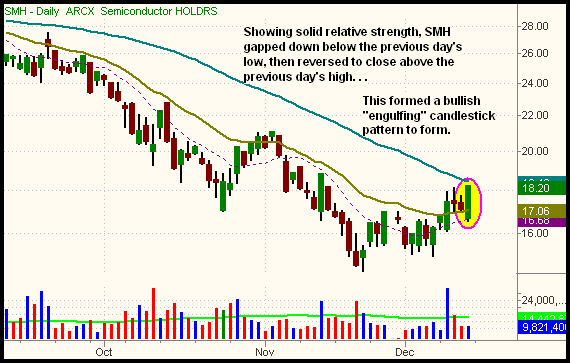| The Wagner Daily ETF Report For December 15 |
| By Deron Wagner |
Published
12/15/2008
|
Stocks
|
Unrated
|
|
|
|
The Wagner Daily ETF Report For December 15
A negative reaction to the U.S. Senate rejection of the automotive bailout bill last Thursday night caused stocks to open sharply lower in Friday's session, but the broad market showed continued resiliency by quickly reversing to close firmly higher. Led by a 4.7% jump in the Philadelphia Semiconductor Index ($SOX), the Nasdaq Composite gained 2.2%. The S&P 500 and Dow Jones Industrial Average lagged behind by rising 0.7% and 0.8% respectively. The small-cap Russell 2000 zoomed 3.8% higher, as the S&P Midcap 400 advanced 2.9%. All the major indices closed near their best levels of the day, but in the middle of last week's trading ranges.
Total volume in the NYSE edged 1% above the previous day's level, while volume in the Nasdaq declined 8%. Higher turnover across the board would have been much more positive, as it would have indicated an appetite for stocks amongst mutual funds, hedge funds, and other institutions. Instead, volume levels during the bullish intraday reversal remained rather tepid. It's been three weeks since trading in either exchange exceeded 50-day average levels. In both the NYSE and Nasdaq, advancing volume exceeded declining volume by a margin of approximately 5 to 2.
Standout ETF performance of last Friday's session was found in the Semiconductor HOLDR (SMH), which formed a "bullish engulfing" candlestick and climbed 6.4%. We bought SMH on December 9, when it surged above its 20-day exponential moving average (EMA) on more than double its average daily volume. After consolidating near that day's high for two straight sessions, last Friday's broad market opening gap down briefly caused SMH to dip back below its 20-day EMA, but the bulls immediately began buying the short-lived pullback. Now, SMH is poised to test resistance of its 50-day MA in the coming days:

Because it represented such a large component of the Nasdaq, the $SOX index used to be an important leading indicator of broad market direction. However, the sector has slowly faded out of the limelight in recent years. Now, one might rationalize the Banking Index ($BKX) has become a similar leading indicator of the overall market. Still, it may be a positive sign for the overall market that the beaten-down semiconductor sector is suddenly showing such relative strength. Though it's unlikely the $SOX (and SMH) will come roaring back in a significant way anytime soon, we're merely playing the momentum of a short-term, countertrend bounce.
In the December 12 issue of The Wagner Daily, we illustrated how, even though the Dow Jones Industrial Average (and other major indices) fell below support of its short-term consolidation pattern the previous day, it settled at major support of its hourly uptrend line from the November 21 low, as well as its prior, intermediate-term downtrend line. Our overall assessment was that the December 11 sell-off was merely a "shakeout" below an obvious level of horizontal price support, and the more substantial convergence of trendline support below was likely to prevent the Dow from going much lower in the short-term. Since all the main stock market indexes moved back above their 20-day EMAs, as well as their December 11 lows, the trendline support levels indeed are "doing their thing."
In the overnight futures market going into December 12, the S&P and Nasdaq futures were trading as much as 5% lower on news that the U.S. Senate rejected the automotive bailout bill. In a bear market environment, this could have led to dire consequences for the following day's market action. Instead, stocks blew off the bad news and actually managed to close higher. This marked the second time in recent weeks that stocks rallied in the face of negative economic news. Previously, stocks were selling off on the release of both bad and good economic news. The 50-day moving averages of the major indices are still in play as key overhead resistance levels, but the December 11 "shakeout" and subsequent reversal may give stocks the necessary momentum to move above last week's highs in the coming days. Nevertheless, trading may be subdued until tomorrow afternoon's Fed announcement on interest rates and economic policy.
Open ETF positions:
Long - SMH, FXI, INP, QLD
Short - (none)
Deron Wagner is the Founder and Head Trader of both Morpheus Capital LP, a U.S. hedge fund, and Morpheus Trading Group, a trader education firm launched in 2001 that provides daily technical analysis of the leading ETFs and stocks. For a free trial to the full version of The Wagner Daily or to learn about Wagner's other services, visit MorpheusTrading.com or send an e-mail to deron@morpheustrading.com.
|